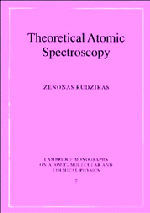Book contents
- Frontmatter
- Contents
- Preface
- Foreword to the Paperback Edition
- Introduction
- Part 1 Energy Spectrum of Many-electron Atom. Radiative and Autoionizing Transitions (Initial Formulas)
- Part 2 Foundations of the Angular Momentum Theory. Graphical Methods
- 5 Angular momentum and tensorial algebra
- 6 Main quantities of angular momentum theory
- 7 Angular momentum theory for relativistic case
- 8 Graphical methods: their generalization for perturbation theory
- Part 3 Description of Complex Electronic Configurations
- Part 4 Second-quantization in the Theory of an Atom. Quasispin and Isospin
- Part 5 Matrix Elements of the Energy Operator
- Part 6 Electric and Magnetic Multipole Transitions
- Part 7 Calculation of Energy Spectra and Electronic Transitions in the Case of Complex Configurations
- Epilogue
- References
- Index
8 - Graphical methods: their generalization for perturbation theory
Published online by Cambridge University Press: 21 September 2009
- Frontmatter
- Contents
- Preface
- Foreword to the Paperback Edition
- Introduction
- Part 1 Energy Spectrum of Many-electron Atom. Radiative and Autoionizing Transitions (Initial Formulas)
- Part 2 Foundations of the Angular Momentum Theory. Graphical Methods
- 5 Angular momentum and tensorial algebra
- 6 Main quantities of angular momentum theory
- 7 Angular momentum theory for relativistic case
- 8 Graphical methods: their generalization for perturbation theory
- Part 3 Description of Complex Electronic Configurations
- Part 4 Second-quantization in the Theory of an Atom. Quasispin and Isospin
- Part 5 Matrix Elements of the Energy Operator
- Part 6 Electric and Magnetic Multipole Transitions
- Part 7 Calculation of Energy Spectra and Electronic Transitions in the Case of Complex Configurations
- Epilogue
- References
- Index
Summary
The graphs of Jucys, Levinson and Vanagas (JLV graphs)
The role of graphical methods to represent angular momentum, 3nj- and jm-coefficients was emphasized in the Introduction as one of the most important milestones in the theory of many-electron atoms and ions.
As was already mentioned, in theoretical atomic spectroscopy, while considering complex electronic configurations, one has to cope with many sums over quantum numbers of the angular momentum type and their projections (3nj- and jm-coefficients). There are collections of algebraic formulas for particular cases of such sums. However, the most general way to solve problems of this kind is the exploitation of one or another versions of graphical methods. They are widely utilized not only in atomic spectroscopy, but also in many other domains of physics (nuclei, elementary particles, etc.).
The main advantage of graphic methods, compared to algebraic ones, is their general character: in fact, you can easily exploit them in any case. They are extremely efficient if you account for the peculiarities and symmetry properties of the quantities considered. The first version of graphical technique (graphs of Jucys, Levinson and Vanagas) was based on the Wigner coefficients (symmetric part of the Clebsch–Gordan coefficient (6.7)) and their symmetry properties. The main element of this technique was the symbol, presented in Fig. 8.1, describing the Wigner coefficient (Eq. (6.8)).
The sign by the vertex (Fig. 8.1) indicates whether the arguments of the Wigner coefficient are ordered in a counter-clockwise direction (positive sign) or a clockwise direction (negative sign). A change of the cyclic order of lines around a vertex corresponds to interchanging two of the columns of the Wigner coefficient.
- Type
- Chapter
- Information
- Theoretical Atomic Spectroscopy , pp. 63 - 70Publisher: Cambridge University PressPrint publication year: 1997



